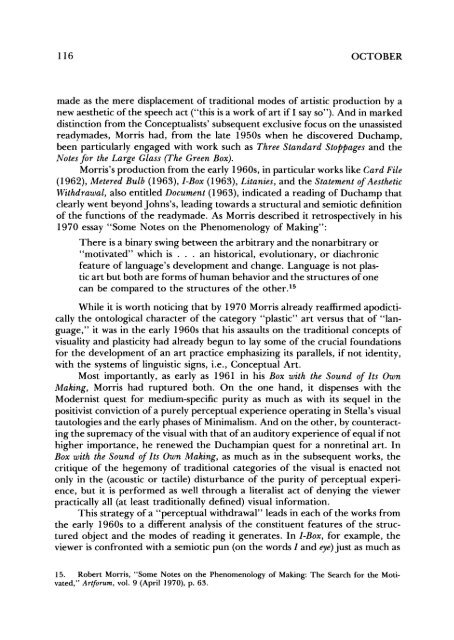Buchloh, conceptual art.pdf - Course Materials Repository
Buchloh, conceptual art.pdf - Course Materials Repository
Buchloh, conceptual art.pdf - Course Materials Repository
Create successful ePaper yourself
Turn your PDF publications into a flip-book with our unique Google optimized e-Paper software.
116 OCTOBER<br />
made as the mere displacement of traditional modes of <strong>art</strong>istic production by a<br />
new aesthetic of the speech act ("this is a work of <strong>art</strong> if I say so"). And in marked<br />
distinction from the Conceptualists' subsequent exclusive focus on the unassisted<br />
readymades, Morris had, from the late 1950s when he discovered Duchamp,<br />
been p<strong>art</strong>icularly engaged with work such as Three Standard Stoppages and the<br />
Notes for the Large Glass (The Green Box).<br />
Morris's production from the early 1960s, in p<strong>art</strong>icular works like Card File<br />
(1962), Metered Bulb (1963), I-Box (1963), Litanies, and the Statement of Aesthetic<br />
Withdrawal, also entitled Document (1963), indicated a reading of Duchamp that<br />
clearly went beyond Johns's, leading towards a structural and semiotic definition<br />
of the functions of the readymade. As Morris described it retrospectively in his<br />
1970 essay "Some Notes on the Phenomenology of Making":<br />
There is a binary swing between the arbitrary and the nonarbitrary or<br />
"motivated" which is . . . an historical, evolutionary, or diachronic<br />
feature of language's development and change. Language is not plastic<br />
<strong>art</strong> but both are forms of human behavior and the structures of one<br />
can be compared to the structures of the other.'5<br />
While it is worth noticing that by 1970 Morris already reaffirmed apodictically<br />
the ontological character of the category "plastic" <strong>art</strong> versus that of "language,"<br />
it was in the early 1960s that his assaults on the traditional concepts of<br />
visuality and plasticity had already begun to lay some of the crucial foundations<br />
for the development of an <strong>art</strong> practice emphasizing its parallels, if not identity,<br />
with the systems of linguistic signs, i.e., Conceptual Art.<br />
Most importantly, as early as 1961 in his Box with the Sound of Its Own<br />
Making, Morris had ruptured both. On the one hand, it dispenses with the<br />
Modernist quest for medium-specific purity as much as with its sequel in the<br />
positivist conviction of a purely perceptual experience operating in Stella's visual<br />
tautologies and the early phases of Minimalism. And on the other, by counteract-<br />
ing the supremacy of the visual with that of an auditory experience of equal if not<br />
higher importance, he renewed the Duchampian quest for a nonretinal <strong>art</strong>. In<br />
Box with the Sound of Its Own Making, as much as in the subsequent works, the<br />
critique of the hegemony of traditional categories of the visual is enacted not<br />
only in the (acoustic or tactile) disturbance of the purity of perceptual experience,<br />
but it is performed as well through a literalist act of denying the viewer<br />
practically all (at least traditionally defined) visual information.<br />
This strategy of a "perceptual withdrawal" leads in each of the works from<br />
the early 1960s to a different analysis of the constituent features of the structured<br />
object and the modes of reading it generates. In I-Box, for example, the<br />
viewer is confronted with a semiotic pun (on the words I and eye) just as much as<br />
15. Robert Morris, "Some Notes on the Phenomenology of Making: The Search for the Motivated,"<br />
Artforum, vol. 9 (April 1970), p. 63.
















